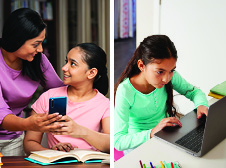Creating a Vision Board with your Child
Amber Brandt
Amber Brandt
Articles by Amber
-
Five Important Conversations to Kick Off a New School Year
Published: Jun 25, 2024
-
4 Ways to Combat the Summer (Learning) Slide
Published: Jun 11, 2024
-
First Day of School: Tips for a Smooth Start
Published: May 09, 2024
-
Healthy and Warm Food Ideas for Cold Days
Published: Mar 19, 2024
One of the most important ways to take action on goals you’ve set for yourself is to keep them posted in a place you regularly see them. Some people like to write out their goals in a journal or planner each morning, while others would rather hang them on a wall, fridge, or bathroom mirror where they can be read daily. One of the most popular ways to keep your goals top-of-mind is by creating a dream or vision board.
While the term may sound a little woo-woo, the idea of a vision board is quite simple — if you create a collage of images and pictures that motivate and inspire you, you’ll have more fuel to work at bringing your dreams to life. Simply said, your vision board serves to remind you why you do what you do and what you want for the future. This tool can help your kids, too.
According to LifeHacker, “Kids are mostly creatures of the moment, but creating a vision board is a great opportunity to talk with them about short-term and long-term dreams and goals. That doesn’t mean we want to force a 10-year-old to pick their future career right this second, but they can start thinking about what inspires them or what they’d like to accomplish.”
Here are a few supplies they’ll need:
- A poster board or large piece of construction paper
- Writing utensils (markers, pens, etc.)
- Scissors
- Glue or tape
- Magazines and catalogs
The vision board your child makes today could be vastly different than the one they’d make in five years, and that’s OK. The exercise is simply meant to be fun and help them wrap their head around current interests and dreams. Here are some questions you can ask to get their gears turning:
- Who most inspires you and why? (This could include athletes, personalities, leaders, living or passed)
- Where would you love to travel someday?
- What jobs or hobbies are you interested in?
- What special talents do you bring to the world? How could they make an impact?
- How do you like to spend your time?
- What would you like to learn to do?
- What do you want to do when you grow up?
Encourage your child to cut out any pictures that make them feel ambitious, and avoid filling the board with material possessions. Steer them toward the “what” they dream of and not the “how” they’ll accomplish it. Check out this site for some practical examples for how a child’s dream board could take shape.


